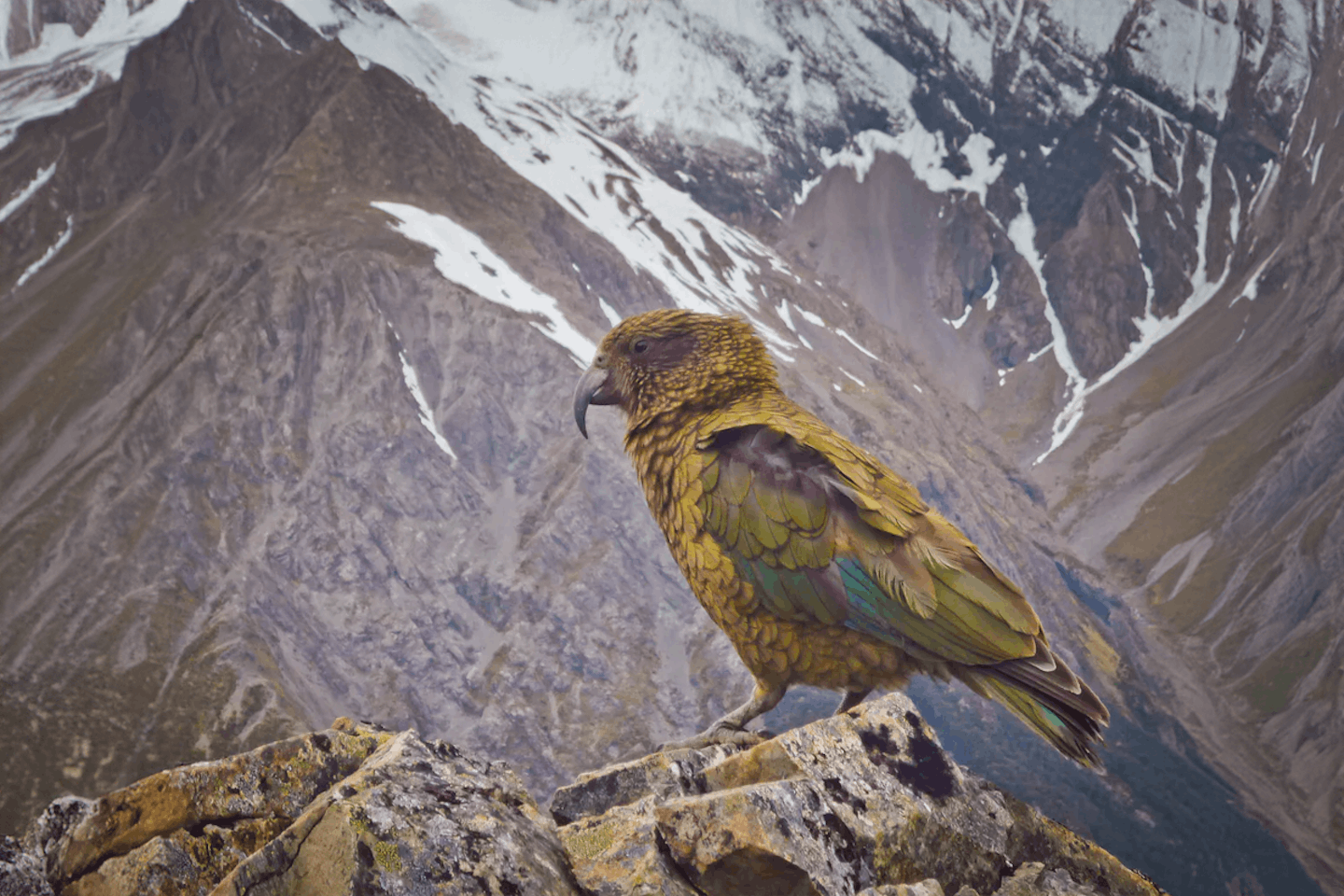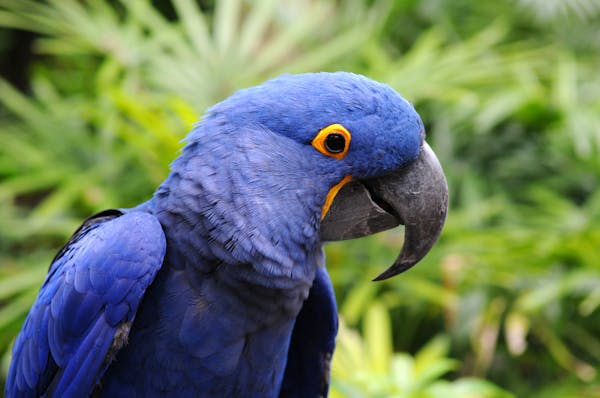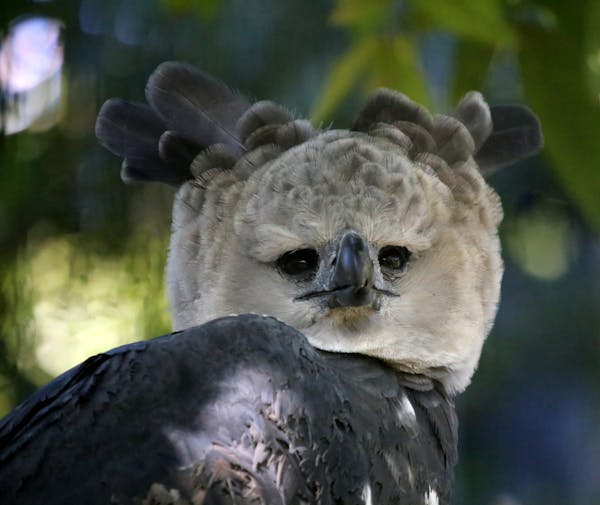Meet the kea parrot: Mischievous guardians of the mountains
One Earth’s “Species of the Week” series highlights an iconic species that represents the unique biogeography of each of the 185 bioregions of the Earth.
The intelligent, inquisitive, and highly endangered kea parrot (Nestor notabilis) is one of nine living endemic parrot species in New Zealand. The species name, Nestor, comes from Greek mythology and means, ‘noteworthy’.
The Māori named the bird kea, which describes the sound of its call in flight (‘kee-aa!’). A flock of keas is known either as a ‘circus of kea’ or a ‘curiosity of kea,’ collective terms that are descriptive of the bird’s nature.
It has also been called “clown of the mountains” for its mischievous and playful antics, which are not always appreciated —especially as kea are notorious for taking delight in prying apart rubber windshield trim and wiper blades on cars, raiding and playing with the contents of tourists’ backpacks and handbags, dismantling skis and snowboards, and flying off with unguarded clothing and other items from campsites and carparks.
“They’ll be flying off with our babies, next!,” a friend reports hearing from a local store owner.
The kea’s paradoxical reputation has been described as that of a playful, cheeky comic, but also that of a vicious killer. (More about that, later.)

Kea parrots (Nestor notabilis) are the iconic species of the New Zealand bioregion (AU1) located in the New Zealand subrealm of Australasia.
Habitat and adaptability of the world's only alpine parrot
Kea are the only alpine parrots in the world, most closely associated throughout their range with the southern beech forests along the alpine ridges of the South Island's rugged mountain regions, such as Arthur’s Pass and Aoraki/Mount Cook National Park.
DNA sequencing and fossil records show that kea were once present in lowland forests and other parts of the country, as well, and elderly Māori describe how kea used to visit the coast in winter but had not been seen in recent times. Ancient kea bones found in sand dunes indicate that they ranged all over the South Island and much of the North Island until the arrival of Polynesian settlers, who began hunting them roughly 750 years ago.
Kea subfossils are commonly found in lowland or coastal sites in the South Island. The current distribution of kea has been shown to reflect the effects of mammalian predators, primarily the humans who drove them into the mountains.Researchers speculated that the kea’s ability to adapt to high alpine environments may have been facilitated by their unique personalities and behavioral repertoire; their high inquisitiveness combined with learning and problem-solving abilities.
A recent study by five international researchers was undertaken out of concern for the warming climate’s potential effects on alpine-adapted and specialized kea. The study attempted to evaluate the birds’ past adaptation to a cooler climate and what evolutionary path had taken them there.
The study’s results confirmed the hypothesis that kea moved to cooler alpine regions simply to avoid human interaction. The researchers concluded that kea are generalists, physiologically capable of surviving from sea level to alpine regions. The birds had adapted to the latter to avoid anthropogenic influences; basically, a human population hell-bent on destroying them.
The research also focused on kea and their genetically similar sister species, the kākā who had adapted to lower-lying forest areas. It determined that no genomic differences exist between the species, indicating that if the alpine regions were to become warmer, it’s possible the kea might return to the forests—a move that would place them back into competition with the kākā. Their adaptability would likely make them capable of surviving both habitat loss and the increased competition presented by a warming climate.
Unique physical traits and vibrant plumage
The kea is a beautiful aerodynamic parrot that’s about the size of a large crow. All parrots have four toes on each foot—two pointing forward and two pointing backward. This allows the birds to manipulate objects with dexterity and move around in trees and on the ground easily—which kea do with a confident swagger.
Their plumage is olive to emerald green with brilliant orange feathers on the undersides of their wings. It’s interesting that their orange feathers can also be seen in the UV spectrum—light waves that we can’t see but many birds and insects can. Other colors include a beautiful royal blue on the top surface of each wing, long flight feathers projecting from their broad tails with barred yellow and black underneath, and red-orange rump feathers.
The kea’s gray-brown beak is long, narrow and gracefully curved. It’s quite different in shape from that of its lowland forest cousin, the kākā, whose beak is much thicker and shorter. This is because the kea dig grubs from rotten logs and roots from the ground, while the kākā’s beak is adapted to cracking open hard seeds and nuts.
The adults have dark-brown irises and the cere (the waxy, fleshy covering at the base of the upper beak), eye rings and legs are gray. Juvenile kea generally resemble adults, but have yellow eye rings and cere, an orange-yellow lower beak, and gray-yellow legs.
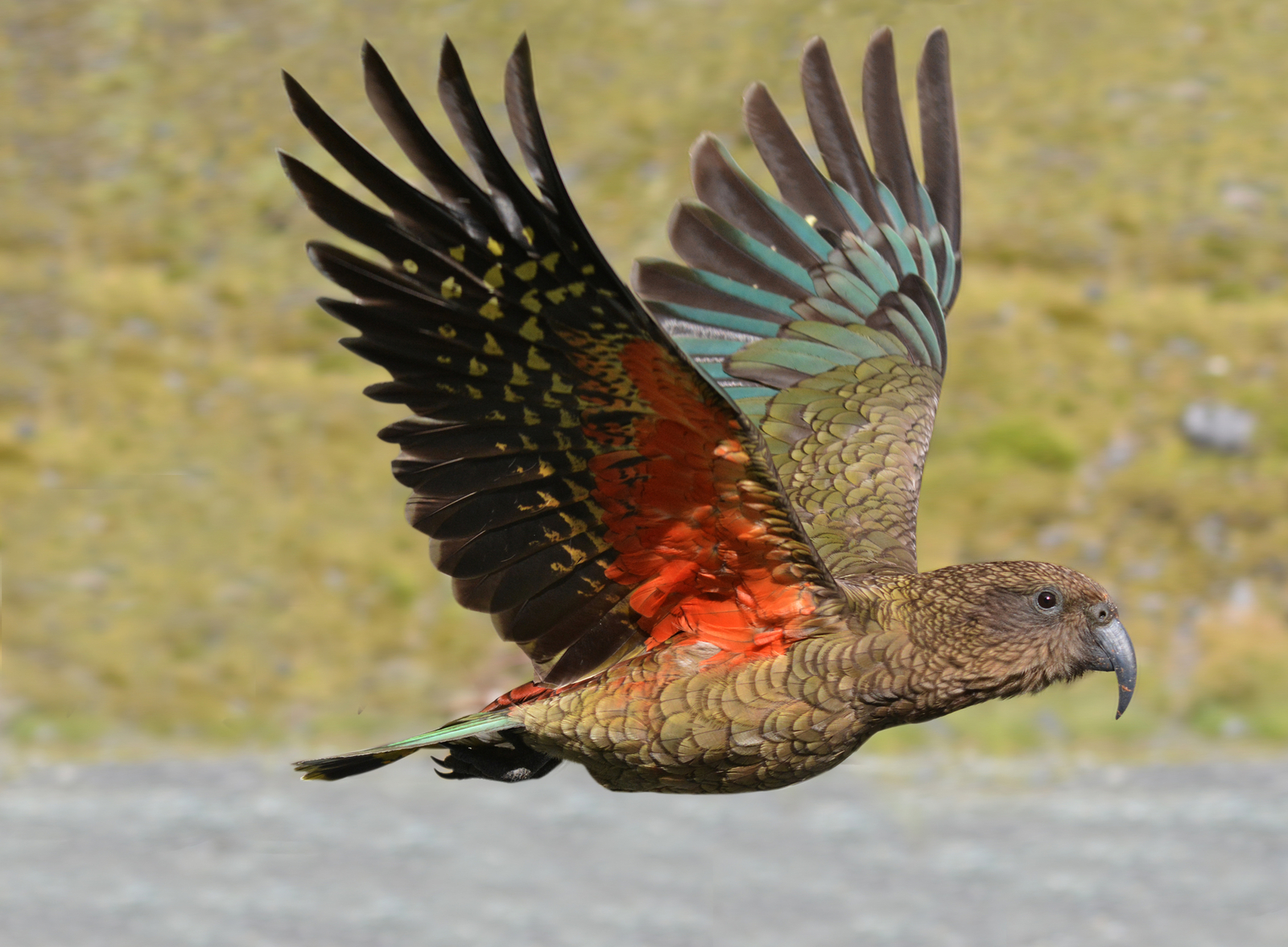
A kea parrot flies in motion in Fiordland, New Zealand, showing off its vibrant plumage. Image credit: © Rafael Ben Ari | Dreamstime
Masters of play and problem-solving
Indicative of their complex cognitive abilities, kea can solve logical puzzles, will work together to achieve shared objectives, and have often been observed preparing and using tools. Their curiosity and their urge to explore and manipulate their surroundings have served both to help them adapt to environmental pressures and get them into heaps of trouble.
Play is also a vital part of their socialization, and kea even have a “play call” which apparently encourages others to join in the fun, and is thought to be an equivalent to human laughter. Kea roll snowballs back and forth to each other, play-fight, and fly high up into the air to toss objects for their friends to catch (likely including new toys stolen from purses and backpacks).
Omnivorous diet and role in the ecosystem
Kea are omnivores who feed mainly on roots, leaves, berries, nectar, and insects. Their diet includes more than 40 plant species, beetle larvae, grasshoppers, land snails, birds such as nesting shearwater chicks, and mammals that include sheep, rabbits and mice, and carrion. They have also taken full advantage of human gifts and garbage food.
Canterbury University researchers found that kea select and consume more fruiting species and disperse more seeds than all other alpine birds combined. They play a vitally important role in maintaining the health of New Zealand’s alpine ecosystems through their distribution of seed in high country areas, and also through the pollination of native vegetation.
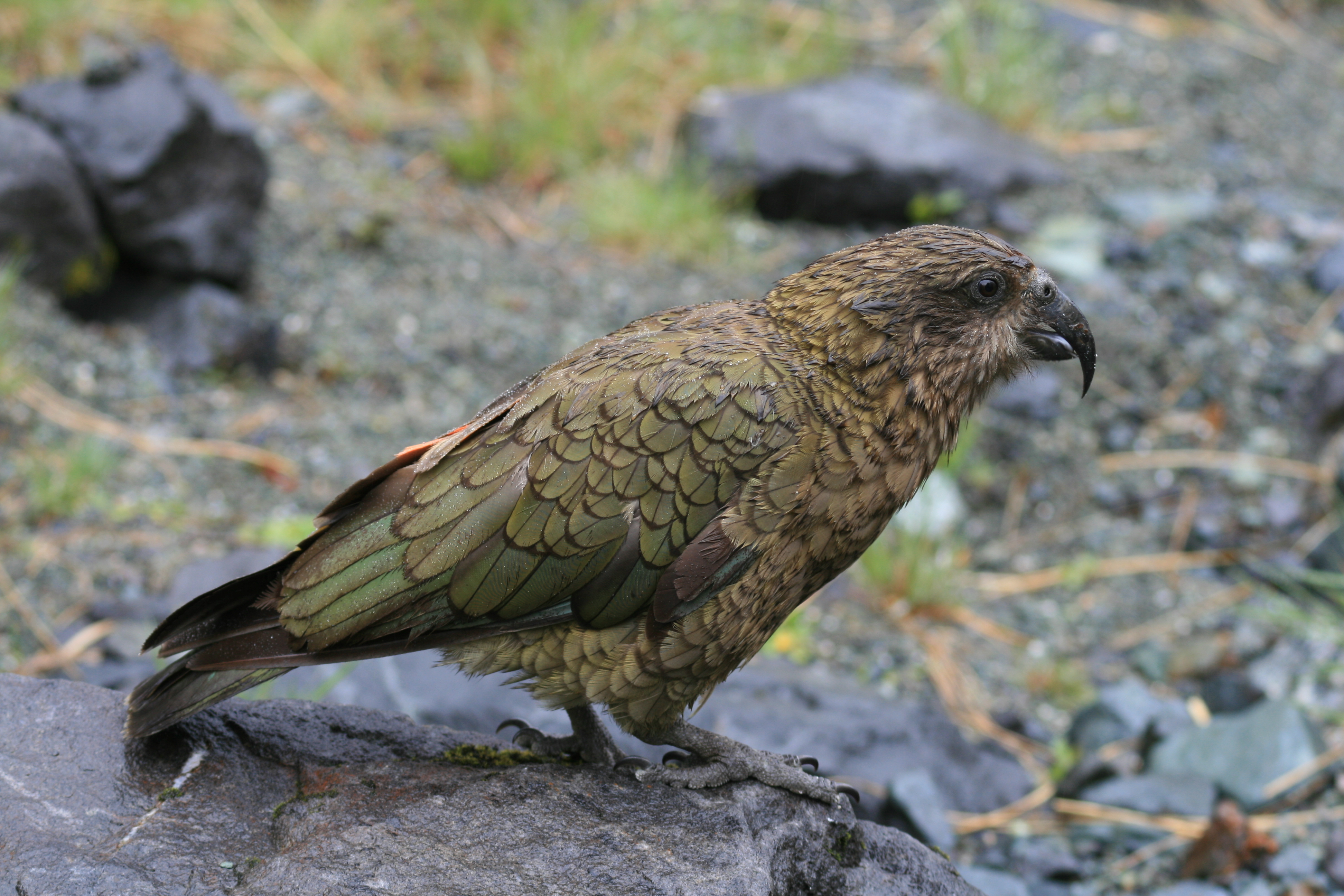
Kea parrots help disperse the seeds of more than 40 plant species throughout their habitat. Image credit: Wikipedia, Mark Whatmough (CC by 2.0)
Sheep attacks and near extermination
Unfortunately, another dietary source led to the kea’s near extermination. As sheep farmers began moving into the high country in the mid 1860s, sheep began suffering from unusual wounds. A kea was first witnessed attacking a sheep in 1868, and similar accounts became widespread. By the late 1880s, this change in behavior had been accepted by prominent members of the scientific community.
It was noted that the mostly nocturnal attacks were more frequent during winter, and snow-bound sheep with two years growth in their fleece were the most vulnerable. Newly shorn sheep in warm weather were rarely victims. The kea’s assaults were finally captured on video in 1992, proving that at least some kea will attack and feed on healthy sheep. The video confirmed that the kea use their powerful, curved beaks and claws to rip through the layer of wool and eat the fat from the back of the animal. Although they don’t kill the sheep directly, death can result from infections or accidents suffered by animals’ attempts to escape.
These attacks so incensed early New Zealand sheep farmers that the government put a generous bounty on kea beaks—a policy that continued from the late 1870s for about a century until 1970 and resulted in the near eradication of the kea species.
Since the endangered kea are now protected, their occasional depredations are generally tolerated by sheep farmers. The general consensus is that the damage done to sheep was grossly exaggerated, and where it occurred was due mainly to the birds’ hunger. In the past, when their food supply was reliable and plentiful, Kea existed in high numbers in the vicinity of sheep farms without attacking the animals.
As it is known that innovative young males commonly instigated the attacks, which others imitate, identifying and removing those individuals is considered a viable and humane solution.
High altitude breeding and nesting habits
Only about half of all adult females breed in any given year. Reproducing at heights of 1,600 meters (5,200 ft) above sea level and higher, the kea is the only parrot species in the world to spend as much time above the treeline.
Nest sites are made far apart on the ground—as few as one every 1.7 square miles—usually on steep mountainsides. They are created in naturally formed cavities beneath large upland beech trees, in rock crevices, or else burrows dug between roots. The nests are accessed by tunnels leading back from one to six meters (nearly 20 feet) into a larger chamber furnished with lichens, moss, ferns, and rotting wood.
The laying period starts in July and reaches into January. After about three weeks, two to five white eggs are laid, and the female remains on the nest to incubate them, leaving only briefly while the male forages for her and then the entire family, gradually taking over the feeding of the developing chicks. The kea have an unusually long brooding period, as it takes about four months to raise their young from eggs to free-flying fledglings.
.jpg)
The kea's orange feathers can be seen in the UV spectrum—light waves humans can’t see, but many birds and insects can. Image credit: © Rudmer Zwerver | Dreamstime
Mortality rates and population sensitivity
Mortality is high among young kea, with fewer than 40% surviving their first year. Currently, the median lifespan of a wild subadult kea has been estimated at five years, with around 10% of the local kea population estimated to be over 20 years of age.
While they are naturally long lived, the kea’s slow reproduction makes their populations particularly sensitive to changes in adult survival rates, as well as changes in reproductive and juvenile survival rates.
Relationship and significance with the Māori
Kea were considered by the Māori to be taonga, or “treasure,” and respected as kaitiaki, or “guardians of the mountains,” during the Māori’s search for the highly valued Pounamu, or greenstone.
Kea were also eaten by the Māori. The present-day flora and fauna of New Zealand are very different from those among which kea originally evolved, for nearly half of all animal species that were thriving in New Zealand a thousand years ago were killed off after the first seafaring Polynesians arrived between 1200 -1300 AD.
They took advantage of the abundant wildlife, hunting and fishing before dispersing and settling throughout the islands. The arrival of the first humans began one of the largest waves of extinctions in history, referred to as a “biological holocaust.”
Their descendants, the Māori, were concentrated in the North Island, with a few settlements on the South Island. The severe toll on wildlife has continued until very recently, with a new set of humans and other invasive species taking over from the original inhabitants.
.jpg)
The Māori respect the kea as kaitiaki, or “guardians of the mountains.” Image credit: © Jannikmohr | Dreamstime
Protecting kea from predation, poisoning, and human impact
A further steep decline in the kea population has been caused by premature deaths due to predation of kea eggs and fledgling chicks by possums; lead poisoning from roofs and building materials; ill-advised aerial operations to dispense 1080 pesticide to control invasive possums and stoats; deaths from kea frequently breaking into traps baited for stoats; accidents with vehicles; avian diseases; the killing of nuisance individuals; the illicit wildlife trade; and changes in predator abundance, food availability and habitat due to climate change.
Projects are currently being developed to address all nine of these threats. For example, in response to the high numbers of kea deaths due to traffic, the NZ Transport Agency has installed signs to help raise awareness and encourage people to slow down. Kea are often observed among vehicles in roadways because people feed them. (This agency has even filmed kea deliberately dragging traffic cones into the road, possibly to get cars to stop!)
In general, humane methods of controlling both the birds and their invasive predators will help the kea coexist with their human neighbors.
Conservation efforts and the fight to save kea
Partly in response to the decline of its Indigenous biodiversity, New Zealand passed a motion to declare a climate emergency in 2020, specifically citing the “alarming trend in species decline and global biodiversity.”
Kea numbers had already been substantially reduced by the government bounty on kea beaks in response to their reported predation on sheep. A conservative estimate is that over 150,000 birds were culled as late as the 1970s, and the kea population has never recovered.
When a 1970 census counted only 5,000 birds left in the wild, kea began to receive partial protection. Now, they are listed as Nationally Endangered by the New Zealand Threat Classification System and Endangered by the IUCN Red List. Kea are also listed under Appendix II of CITES (Convention on International Trade in Endangered Species of Wild Fauna and Flora), meaning that their international export is highly regulated.
The Kea Conservation Trust, an NGO founded in 2006, is devoted both to the conservation of wild kea in their natural habitat and the improvement of husbandry standards and advocacy potential of kea held in captivity.
A citizen science project called the Kea Database was launched in 2017 so that people could record their kea observations and contribute to an online database for evaluation. If the recorded kea are banded, it’s possible to monitor the habits and behavior of individual named birds.
Some conservationists are calling for kea to be reintroduced into predator-free zones on the North Island, which would be a wonderful example of the international effort to rewild birds and other animals into their native habitats.
While many animals fear the unknown, kea are just the opposite. They’re what scientists refer to as neophilic, or “new-loving.” As kea originally evolved as trusting and curious creatures in a world with almost no predators, this trait will hopefully bode well for the adaptability, coexistence, and future success of these remarkable birds.
Support Nature Conservation